Orange flowers are very eye-catching, and there are plenty of options to select from. A favorite variety is the marigold, which is often used as a decorative plant in gardens and is known for its vivid color. Marigolds are prized for their brilliant orange hues, which can create vibrant borders or add life to flower beds.
The orange bloom itself, which is prized for its pleasant scent, is another common orange blossom. Orange flowers are often used in perfumes and used as a classy wedding decoration. They have a lovely scent that lifts the mood of any event.
In addition, one more popular orange flower species in gardens is the tiger lily. The tiger lily is a strong addition to any landscape, with its bright orange petals spotted with dark dots. All things considered, orange flowers are a wonderful addition to any setting, adding splashes of color and style wherever they grow.
Orange Flowers Name
Marigold Tagetes
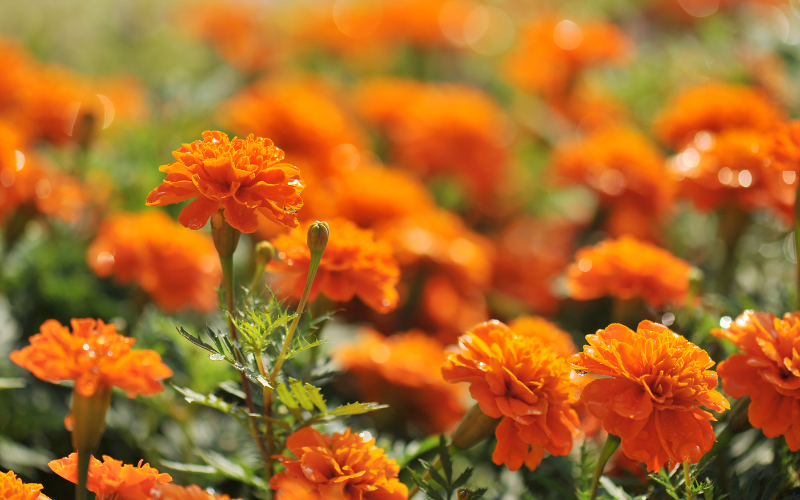
The orange marigold tagetes is a beautiful flower that has been popular for centuries. It is also known as the Tagetes erecta. This flower has a unique orange color and a strong scent that is often used in perfumes and essential oils.
They are also used in traditional medicine to treat various ailments such as stomach aches and headaches. In Hindu culture, these flowers are considered sacred and are used in religious ceremonies and offerings. The orange marigold tagetes are not only beautiful to look at but also have cultural significance and practical uses.
| Scientific Name | Tagetes |
| Native Range | Mexico and Central America |
| Flowering Season | Midsummer to frost |
Tulip
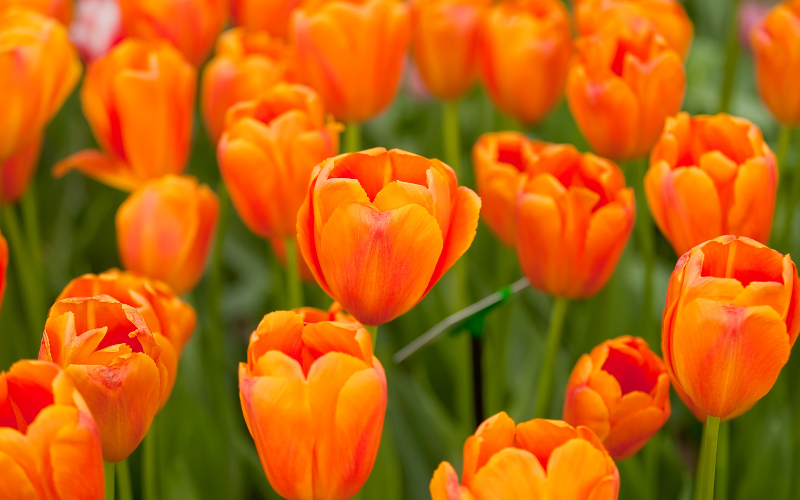
Orange Tulip, is a beautiful flower that is part of the tulip family. This flower is native to Turkey but is now grown in many parts of the world. The Orange Tulipa is known for its vibrant orange color, which stands out in any garden or bouquet.
These flowers typically bloom in mid to late spring and can last for several weeks. They are a perfect addition to any garden or collection of flowers, providing a bold and beautiful statement to any space. Orange Tulipa is an evergreen flower which means that it will bloom year after year, making it a great addition to any garden.
| Scientific Name | Tulipa |
| Native Range | Southern Europe through North Africa, the Middle East, and parts of Asia |
| Flowering Season | Spring |
Dianthus Caryophyllus
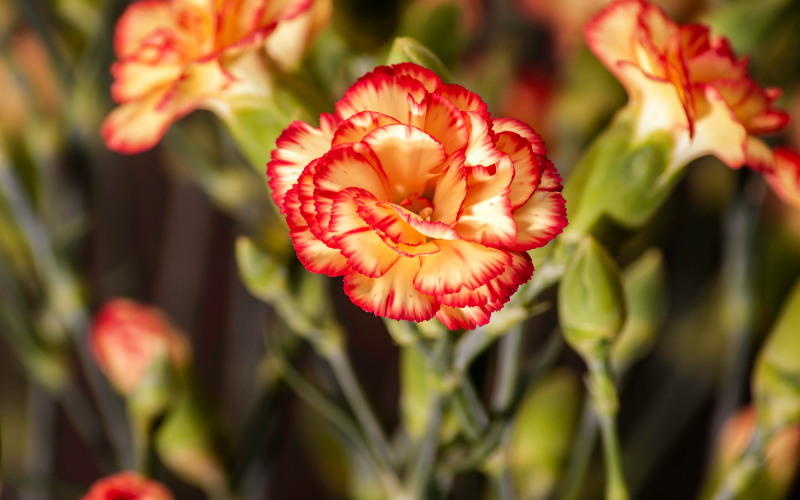
The Orange Dianthus caryophyllus, also known as the Carnation is a beautiful and popular flower that is native to the Mediterranean region. The flower comes in a variety of colors but the orange carnation is particularly striking.
The flower not only looks beautiful but has a lovely fragrance too. It can be grown in a variety of soils and requires minimal maintenance, making it a great choice for both novice and experienced gardeners. With its stunning color and delightful fragrance, the Orange Dianthus caryophyllus is a flower that is sure to brighten up any space. It’s an easy plant to grow and requires minimal maintenance as it prefers moderately fertile, well-drained soil and full sun exposure.
| Scientific Name | Dianthus caryophyllus |
| Native Range | Europe and Asia |
| Flowering Season | Late spring or early summer |
Gerbera Daisy
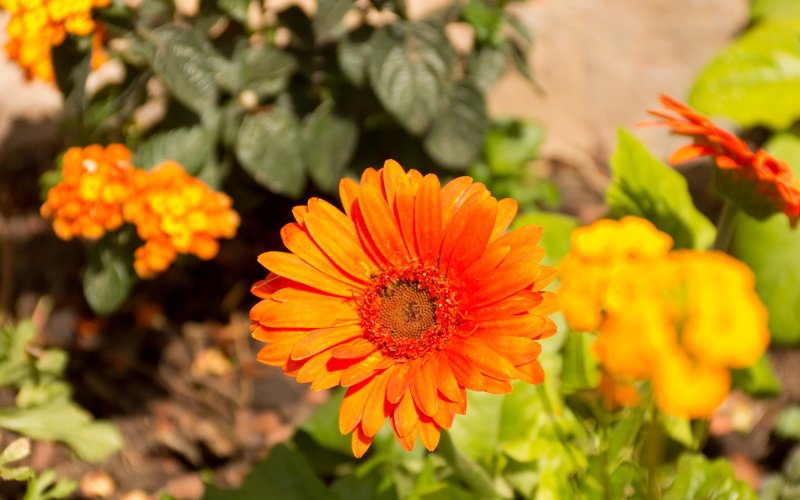
The Orange Gerbera Daisy is a beautiful and vibrant flower that is sure to turn heads. It is also known as the African Daisy and is native to South Africa. The Orange Gerbera Daisy is a symbol of joy, warmth, and energy, and it is often used in floral arrangements to bring a pop of color and cheer to any room.
These daisies have a distinct orange hue that is eye-catching and warm. They are also known for their long-lasting blooms, making them a great addition to any garden or home. The Orange Gerbera Daisy is also known for its ability to attract butterflies, making it a great addition to any garden. If you are looking to brighten up your garden or spice up your home decor, the Orange Gerbera Daisy is a perfect choice.
| Scientific Name | Gerbera |
| Native Range | South Africa |
| Flowering Season | Late spring through autumn |
Daylily Hemerocallis
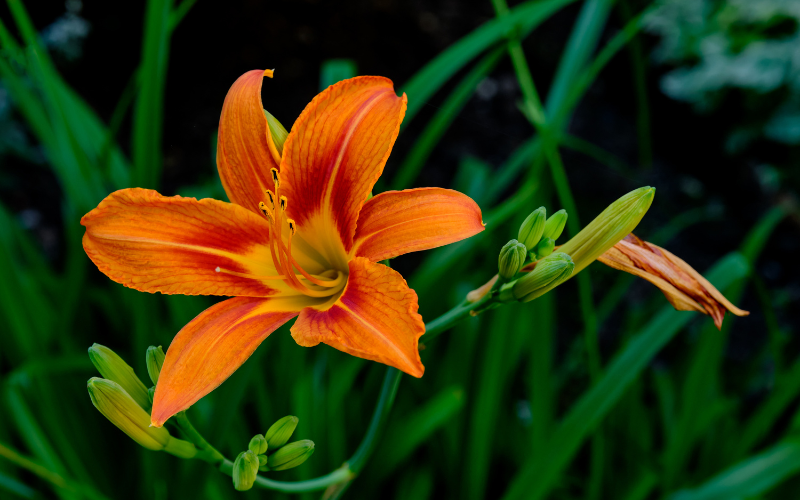
The Orange Daylily, also known as the Hemerocallis fulva, is a beautiful bright orange flower that blooms during the summer months. It is a hardy plant that is very easy to grow and can adapt to many different soil types.
The Orange Daylily is known for its trumpet-shaped flowers that range in size from 2-3 inches. It is also a low-maintenance plant that requires little attention, making it a great choice for gardeners of all skill levels. The Orange Daylily is a beautiful addition to any landscape and is sure to bring joy and beauty to all who appreciate its vibrant and eye-catching blooms.
| Scientific Name | Hemerocallis |
| Native Range | Asia |
| Flowering Season | Spring through summer |
Iris

The Orange Iris, also known as the Copper Iris, is a stunning flower that captures the beauty of the sunset in its petals. The vibrant orange color of the petals is truly something to behold.
The Iris is a genus of flowering plants with showy flowers. This flower also has a deep symbolism, representing strength, wisdom, and good luck. The Orange Iris is truly a stunning flower that is sure to make a statement wherever it is found. The Orange Iris is a hardy and easy-to-grow plant that can thrive in a variety of soil types and climates.
| Scientific Name | Iris |
| Native Range | Europe and Asia |
| Flowering Season | Late spring to early summer |
Ranunculus
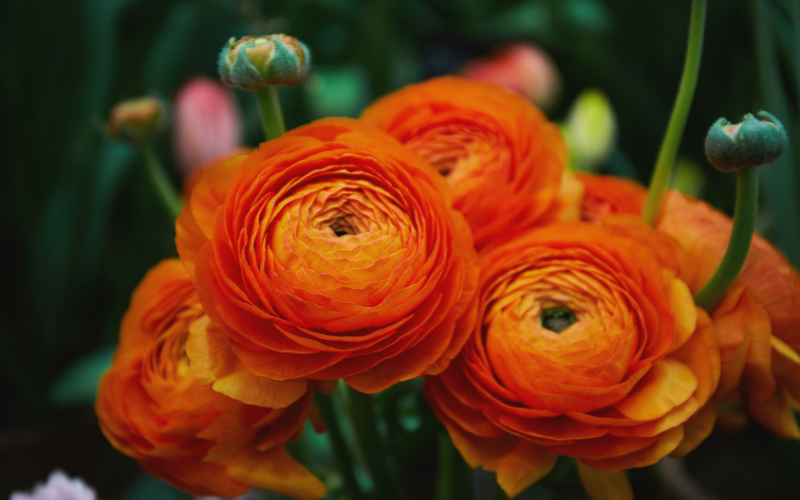
Orange Ranunculus is a beautiful type of flower that has a bright and brilliant look. These flowers have multiple layers of delicate petals which creates a unique and intricate design. Orange Ranunculus blooms are cup-shaped and have multiple layers of delicate petals.
They bloom in the spring and early summer, bringing a sense of joy and warmth to any environment. These flowers are easy to care for and require regular watering and sunlight. Orange Ranunculus is the perfect flower to brighten up any room or occasion with its cheerful and eye-catching appearance. These flowers are also known for their long vase life, making them a popular choice for cut flower arrangements.
| Scientific Name | Ranunculus |
| Native Range | Europe, Asia, and North America |
| Flowering Season | Early spring right through to the beginning of summer |
Alstroemeria
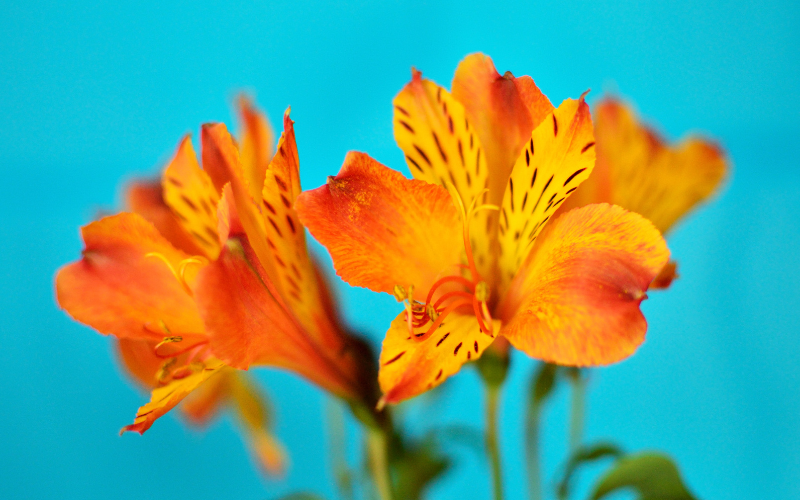
Orange Alstroemeria are stunning flowers with vivid orange petals that are sure to brighten up any room. These flowers are native to South America and are often used in floral arrangements because they are long-lasting and easy to care for.
They grow on tall stems and have multiple blooms per stem, making them a great choice for creating a full bouquet. Orange Alstroemeria is also known for its symbolic meaning, which includes friendship, devotion, and support. Orange Alstroemeria is relatively easy to care for and can tolerate a wide range of temperatures and soil conditions. With proper care, these beautiful flowers can bloom for weeks on end, bringing joy and beauty to any space.
| Scientific Name | Alstroemeria |
| Native Range | South America |
| Flowering Season | Summer and autumn |
Lion’s Tail
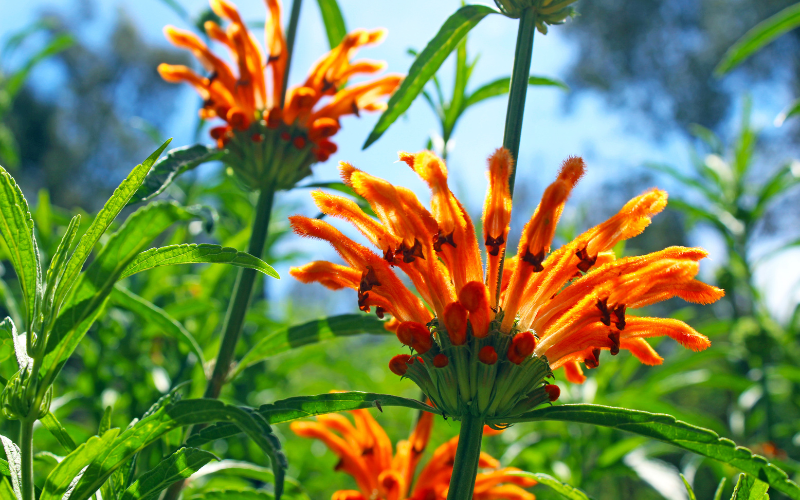
The Orange Lion’s Tail, scientifically known as Leonotis leonurus, is a unique and striking plant that is native to southern Africa. Its bright orange flowers, which bloom in late summer and fall, attract bees, making it a great addition to any garden.
Orange Lion’s Tail is also known for its medicinal properties. In traditional African medicine, it has been used to treat a variety of ailments including coughs, colds, and fevers. The leaves can be brewed into tea, and the plant’s seeds and roots have also been used in folk medicine. Overall, Orange Lion’s Tail is a versatile and beautiful plant that is worth considering for any garden or herbal medicine cabinet.
| Scientific Name | Leonotis leonurus |
| Native Range | South Africa and Southern Africa |
| Flowering Season | Late spring through fall |
Crown Imperial
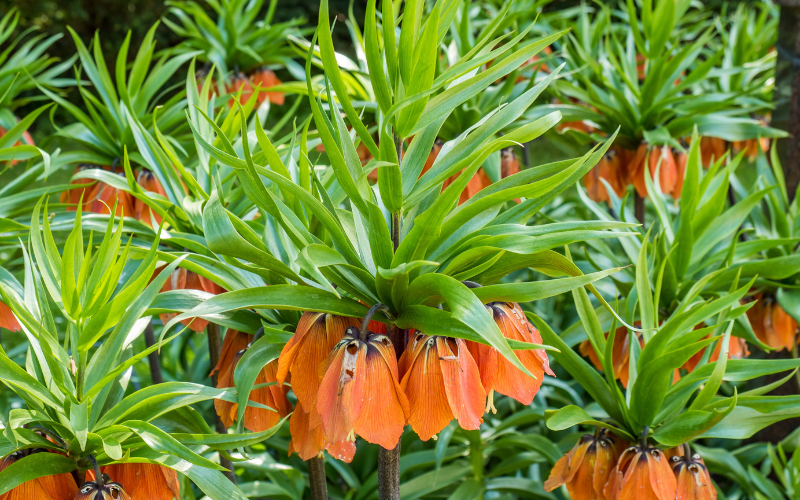
The Orange Crown Imperial is a beautiful and unique plant that belongs to the lily family. It is native to Asia and can grow up to three feet tall with a spread of one to two feet. The plant produces stunning orange flowers that are arranged in a crown-like shape at the top of the stem, hence the name “Crown Imperial”.
The flowers are pendulous in shape and can grow up to 3-4 inches long. The plant prefers well-drained soil and a sunny location, making it perfect for gardens and borders. It is also a favorite of bees and butterflies, making it a great addition to any pollinator-friendly garden. Overall, the Orange Crown Imperial is a stunning plant that adds a burst of color and interest to any landscape.
| Scientific Name | Fritillaria imperialis |
| Native Range | Afghanistan, Iran, Iraq, Pakistan, and Turkey |
| Flowering Season | Spring through summer |
African Tulip Tree
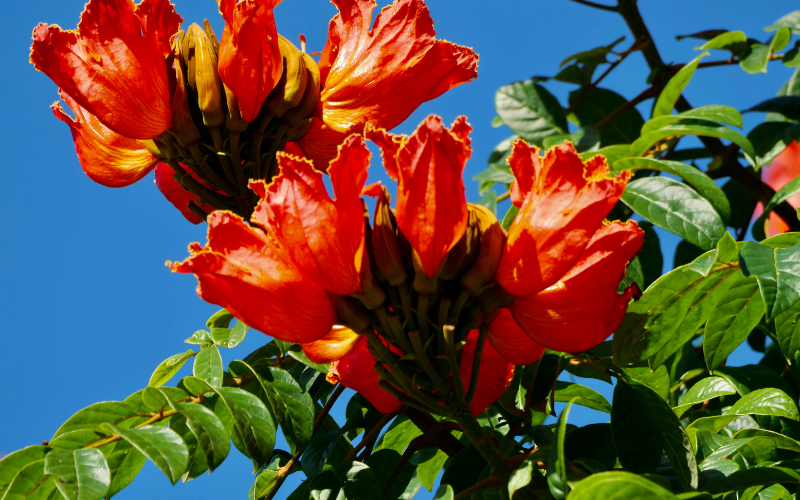
The African Tulip Tree is a stunning and vibrant flowering tree. It is also known as Spathodea campanulata. It is native to tropical regions of Africa. The flowers are large, ranging from 3 to 5 inches (8 to 13 centimeters) in length, and have bright orange to reddish-orange petals.
The African Tulip Tree is known for its popular flowering, which typically occurs during the warm and rainy season in tropical regions.
| Scientific Name | Spathodea campanulata |
| Native Range | Tropical Africa |
| Flowering Season | Spring |
Butterfly Weed

Butterfly Weed (Asclepias tuberosa) is a beautiful and beneficial perennial plant. It is native to North America. Butterfly Weed is a herbaceous plant that typically grows 1 to 3 feet (30 to 90 centimeters) tall.
Butterfly Weed usually blooms during the summer months, from late spring to early fall. Butterfly Weed thrives in full sun and prefers well-draining, sandy, or loamy soil.
| Scientific Name | Asclepias tuberosa |
| Native Range | Eastern and Southwestern North America |
| Flowering Season | Summer |
Calendula
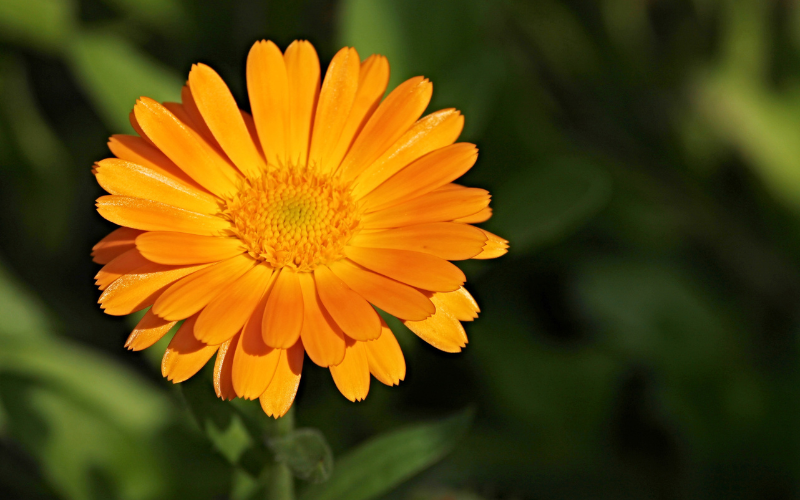
The calendula flower is a vibrant and versatile flower. It is also known as a pot marigold. This beautiful flower is native to southern Europe. Calendula plants produce bright and cheerful daisy-like flowers with vibrant yellow to orange petals.
The flowers are typically 2 to 3 inches (5 to 7.5 centimeters) in diameter and have a central disc that can range from dark brown to green. It blooms profusely during the spring and fall, and in milder climates, it may continue to flower throughout the winter.
| Scientific Name | Calendula officinalis |
| Native Range | Southern Europe |
| Flowering Season | Spring to Summer |
Impatiens
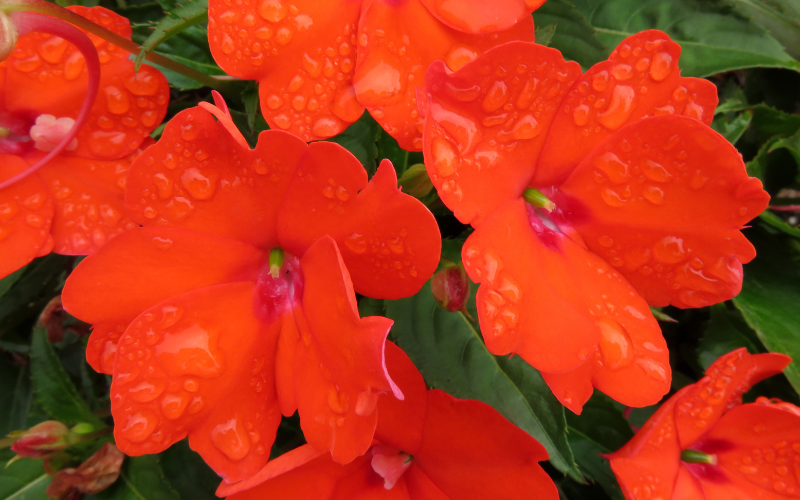
The Impatiens is a beautiful flower. It is native to East Africa. Impatiens flowers come in a wide range of colors, including shades of pink, red, orange, purple, white, and bicolor varieties.
They thrive in well-draining, fertile soil that retains moisture but does not become waterlogged. Impatiens prefer moderate temperatures and can suffer in extreme heat or freezing temperatures. They are typically grown as annuals in temperate climates.
| Scientific Name | Impatiens |
| Native Range | Asia, Africa, North America, and Oceania |
| Flowering Season | Early Summer |
Chinese Lantern Plant
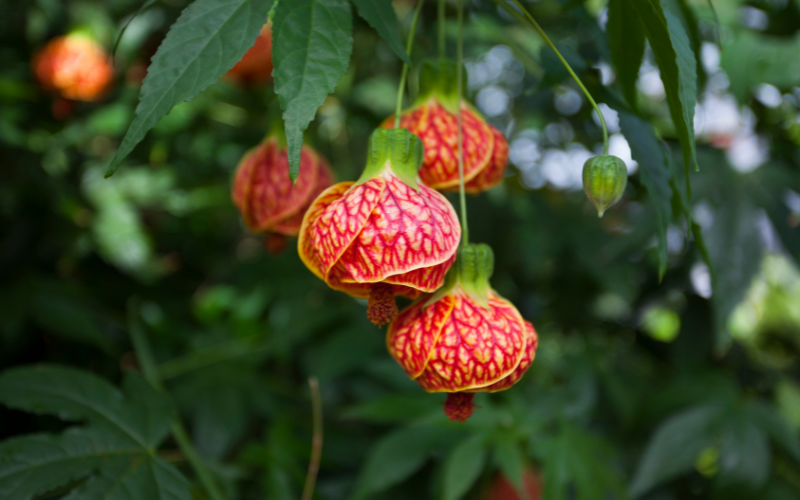
The Chinese Lantern Plant is a beautiful and unique flower. It is also known as Physalis alkekengi. It is native to parts of Europe and Asia. The Chinese Lantern plant is a herbaceous perennial that can grow up to 2 to 3 feet (60 to 90 centimeters) in height.
They bloom in late spring to early summer. The Chinese Lantern plants prefer full sun to partial shade and well-draining soil. They are relatively low-maintenance.
| Scientific Name | Physalis alkekengi |
| Native Range | Europe, Asia |
| Flowering Season | Late summer-early fall |
Helenium
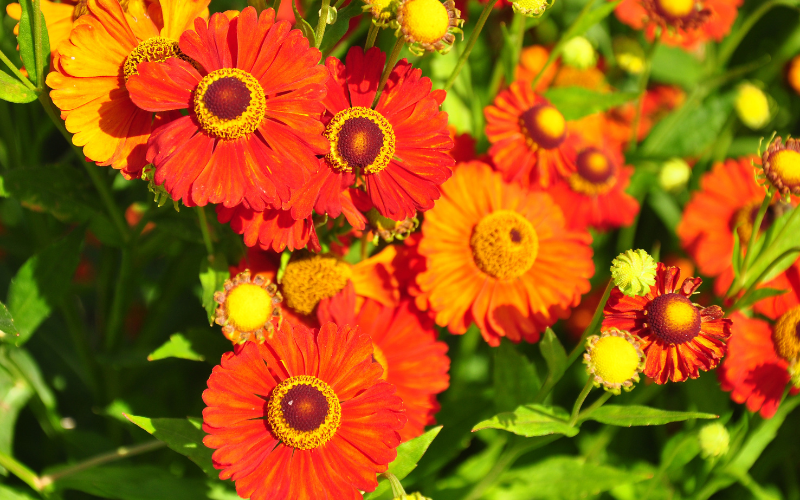
The Helenium is a beautiful flower. It is native to North and Central America. The flower can come in various colors, including shades of yellow, orange, red, and brown.
The flowering season for Helenium typically occurs in late summer to early fall. Helenium prefers full sun to partial shade and well-draining soil. They are generally low-maintenance plants. This flower belongs to the Asteraceae family.
| Scientific Name | Helenium |
| Native Range | North American |
| Flowering Season | Late Summer to Autumn |
Climbing Penstemon
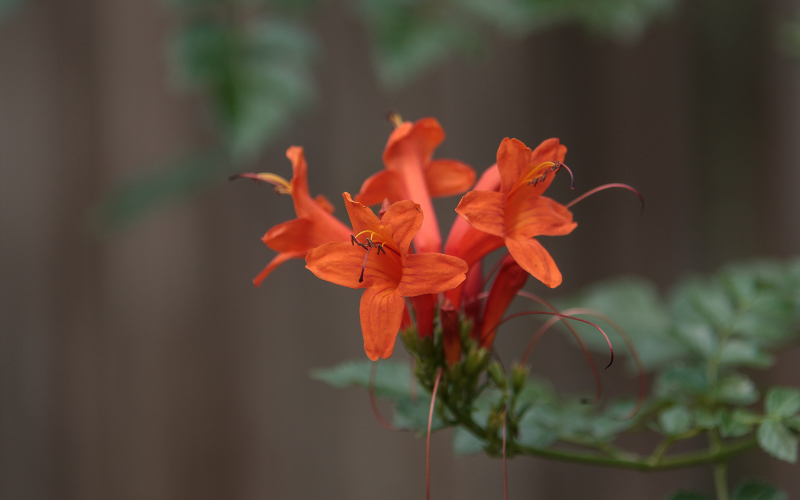
Climbing Penstemon is a stunning flower. It is also known as Penstemon heterophyllus. It is native to California, USA. The flowers of the Climbing Penstemon come in a range of hues, from deep purples and blues to vibrant pinks and reds.
Climbing Penstemon thrives in sunny and dry conditions, making it a perfect choice for those who live in arid climates. The slender stems of the Climbing Penstemon can reach heights of up to four feet, gracefully cascading down walls, fences, or trellises.
| Scientific Name | Keckiella cordifolia |
| Native Range | Southern California |
| Flowering Season | Spring through summer |
Cockscomb
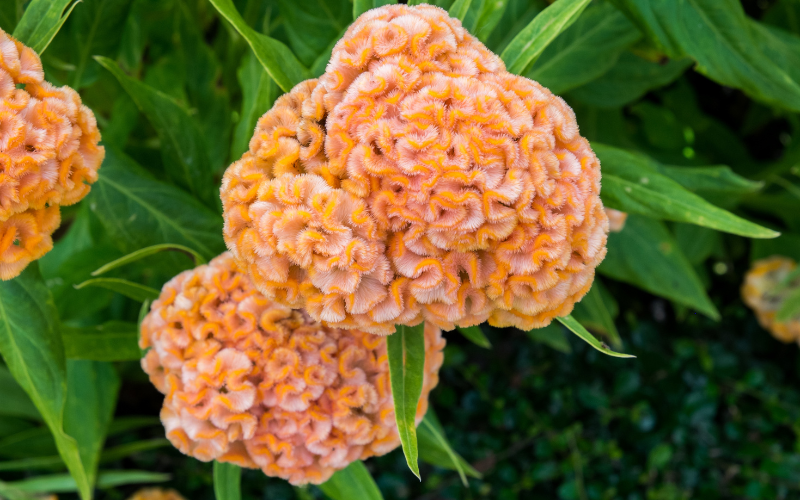
Cockscomb is a fascinating and unique flowering plant. It is scientifically known as Celosia cristata. This beautiful flower is native to tropical regions of Asia.
The flower heads can vary in color and size, with popular colors being shades of red, pink, orange, yellow, and sometimes even purple. Cockscomb thrives in warm climates and prefers full sun exposure. Cockscomb flowers typically bloom during the summer and fall months.
| Scientific Name | Celosia |
| Native Range | Asia, Africa, and America |
| Flowering Season | Summer, fall |
Jamaican Rain Tree
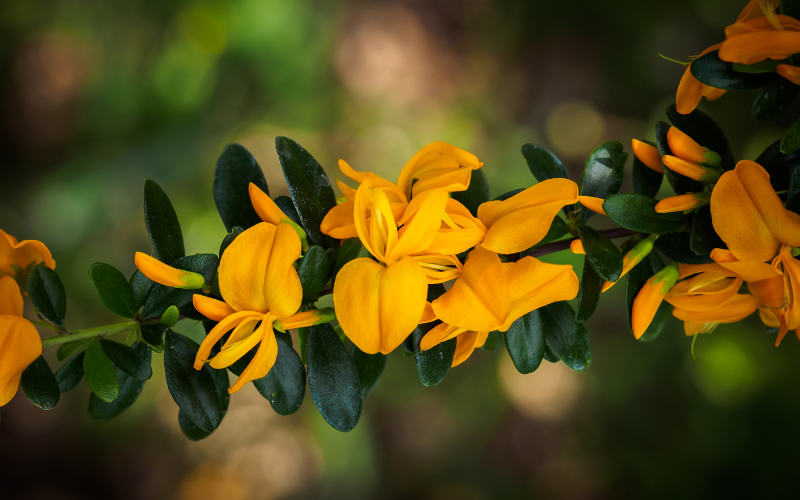
The Jamaican Rain Tree is a beautiful flower. It is scientifically known as brya ebenus. It is native to the tropical regions of the Americas. Jamaican Rainforests typically flower during the wet or rainy season.
The blossoms are large and showy, boasting a stunning array of colors, including shades of pink, purple, and white. Not only are these flowers visually stunning, but they also emit a sweet and fragrant scent that fills the air.
| Scientific Name | Brya ebenus |
| Native Range | The Caribbean islands of Cuba and Jamaica |
| Flowering Season | Throughout the year |
Bird of Paradise
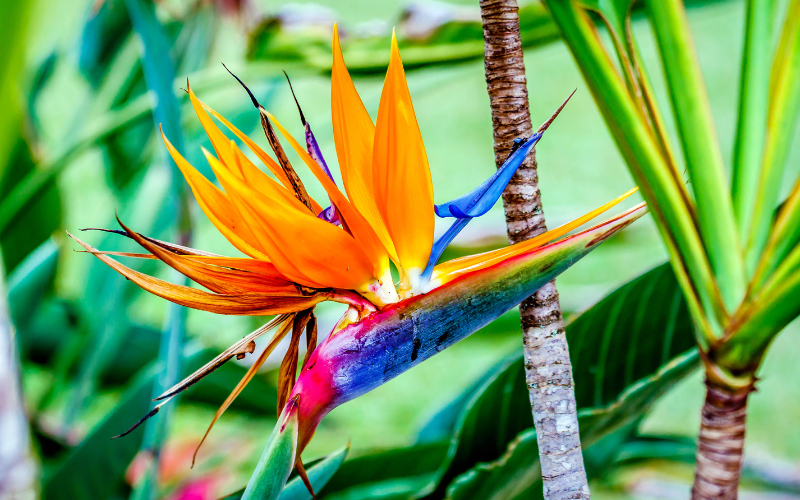
The Bird of Paradise flower is a stunning tropical plant. It is scientifically known as Strelitzia Reginae. It is native to South Africa. The Bird of Paradise flower features a unique and intricate flower structure.
It consists of three upright orange or yellow sepals and three blue petals. The Bird of Paradise can bloom multiple times throughout the year. It can reach a height of about 4 to 6 feet (1.2 to 1.8 meters) and forms dense clumps.
| Scientific Name | Strelitzia |
| Native Range | South Africa |
| Flowering Season | Throughout the year |
Frangipani
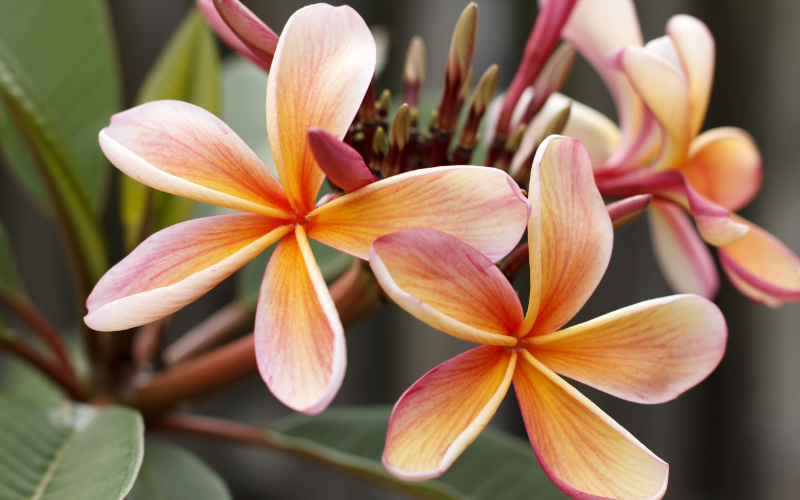
Frangipani is a beautiful flower. It is also known as Plumeria. It is native to regions of Central America. Frangipani flowers come in a variety of colors, including white, yellow, pink, red, and multi-colored combinations.
Frangipani flowers typically bloom during the warmer months, most commonly in the spring and summer. It requires well-draining soil, plenty of sunlight, and protection from frost.
| Scientific Name | Plumeria rubra |
| Native Range | Central America and Mexico, Caribbean Islands, Northern South America, Pacific Islands, and Southeast Asia |
| Flowering Season | Late spring to summer |
Flame of the Forest
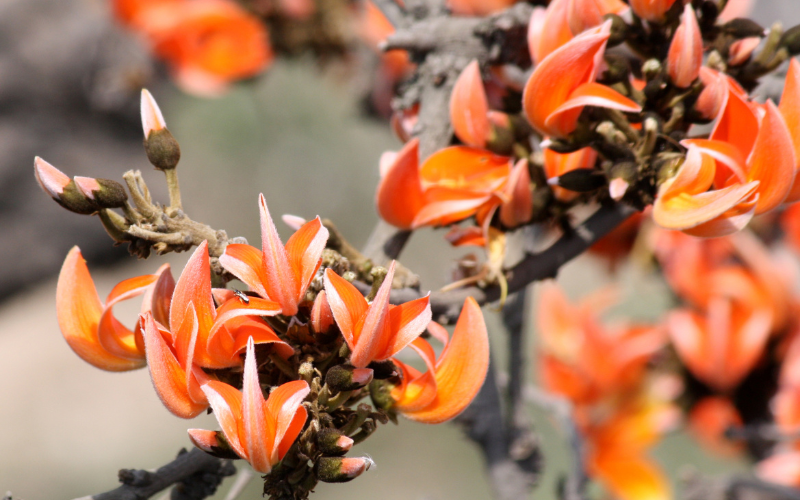
The Flame of the Forest is a stunningly vibrant flower. It is scientifically known as Butea monosperma. It is native to South Asia. The Flame of the Forest typically blooms during the spring season.
The Flame of the Forest produces large clusters of fiery red, orange, or sometimes yellow flowers that resemble flames. They thrive in well-draining soil and are well-adapted to the tropical and subtropical climates of the region.
| Scientific Name | Butea monosperma |
| Native Range | Asia |
| Flowering Season | Spring |
Dahlia
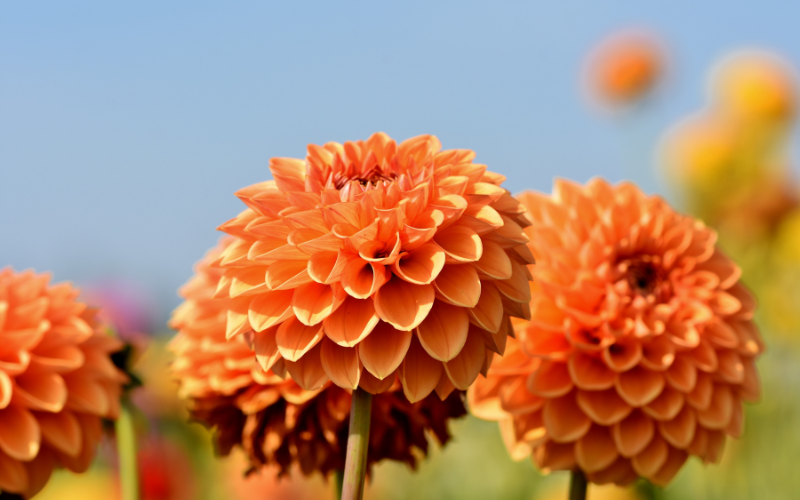
Dahlia is a beautiful flower. They belong to the Asteraceae family and are native to Central America. The sizes of the flowers can range from small, 2-inch blooms to large.
It comes in a range of white, yellow, orange, pink, red, purple, and even bi-color and multi-color varieties. The blooming period of Dahlias typically starts in the summer and can extend well into the fall. Dahlias thrive in full sun and well-draining soil.
| Scientific Name | Dahlia |
| Native Range | Mexico and Central America |
| Flowering Season | Late Spring to Summer |
Cymbidium Orchid
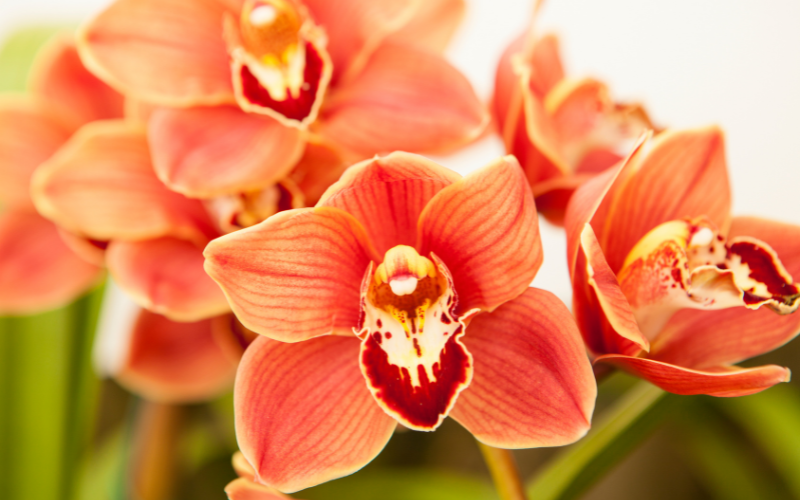
The Cymbidium orchid is a stunning flower. It is also known as the boat orchid. It is native to Asia and Australia. The flowers can be small or large, and their color palette includes shades of white, yellow, green, pink, purple, and even multicolored combinations.
The flowers are large, often measuring up to 4 inches in diameter. With proper care, these flowers are sure to bring joy and beauty to any space they grace.
| Scientific Name | Cymbidium |
| Native Range | Asia and Australia |
| Flowering Season | Fall, Winter, Spring |
Mexican Sunflower

Mexican Sunflower is a beautiful flower. It is also known as Tree Marigold or Mexican Marigold. It is native to Mexico and Central America. Mexican Sunflowers can grow quite tall, often reaching heights of 6 to 10 feet (1.8 to 3 meters) or more.
Mexican Sunflowers are known for their long blooming period, which typically spans from mid-summer to the first frost in fall.
| Scientific Name | Tithonia |
| Native Range | North America, Central America |
| Flowering Season | Summer, Fall |
Million Bells
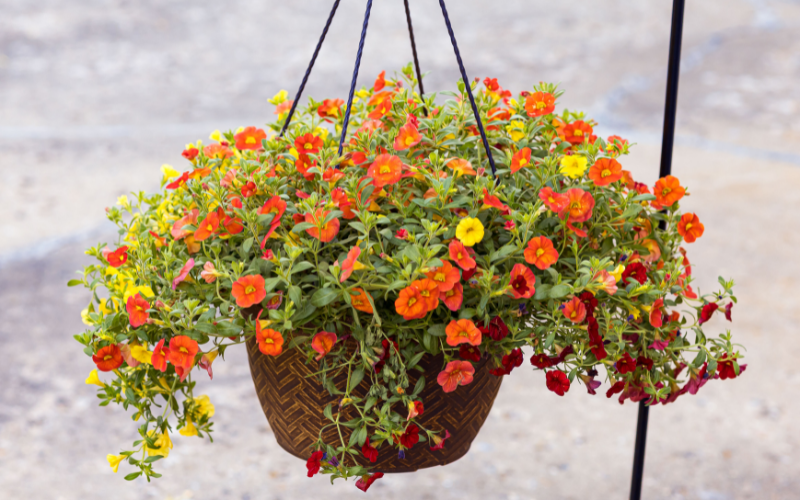
The Million Bells is a stunning and vibrant flower. It is scientifically known as Calibrachoa. The flowers are typically trumpet-shaped or bell-shaped, and they come in a wide range of colors, including shades of red, pink, orange, yellow, purple, and white.
It can bloom in the spring and continue until the first frost in the fall. Million Bells are trailing or cascading plants, making them excellent choices for hanging baskets and containers.
| Scientific Name | Calibrachoa |
| Native Range | South America |
| Flowering Season | Spring to frost |
Cosmos
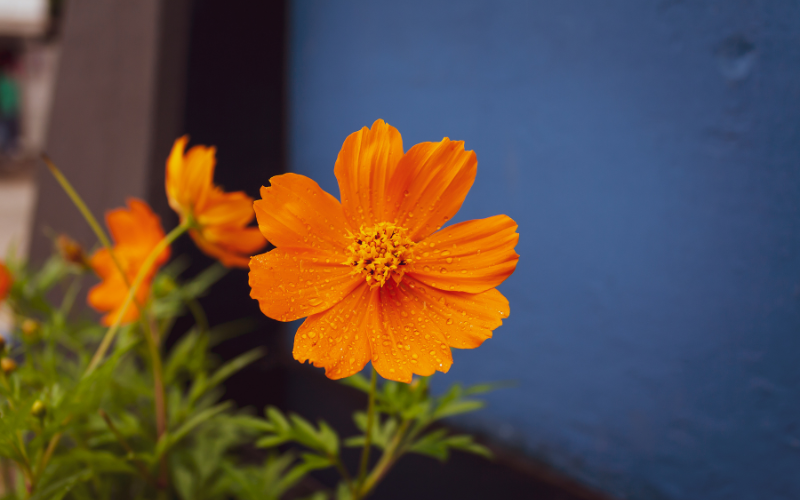
Cosmos is a beautiful flower. This flower belongs to the Asteraceae family. It is native to North and South America. The flower can be white, pink, red, orange, or even bi-colored.
Cosmos flowers typically start blooming in late spring or early summer. Cosmos plants can vary in height, with some dwarf varieties reaching around 12 inches (30 cm) and taller varieties growing up to 6 feet (1.8 meters) or more.
| Scientific Name | Cosmos |
| Native Range | Mexico |
| Flowering Season | Summer |
Nasturtium
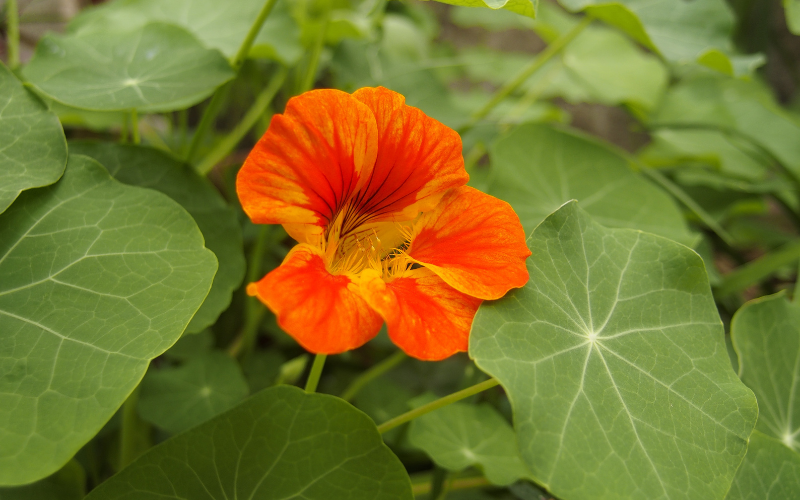
Nasturtium is a beautiful flower. It is native to South America. Nasturtium flowers come in a range of warm and cheerful colors, including shades of orange, yellow, red, and sometimes cream.
Nasturtiums can have a trailing or climbing growth habit, making them suitable for hanging baskets, window boxes, and garden borders. Nasturtiums typically start blooming in late spring or early summer.
| Scientific Name | Tropaeolum |
| Native Range | America |
| Flowering Season | Late spring to early summer |
Painted Abutilon
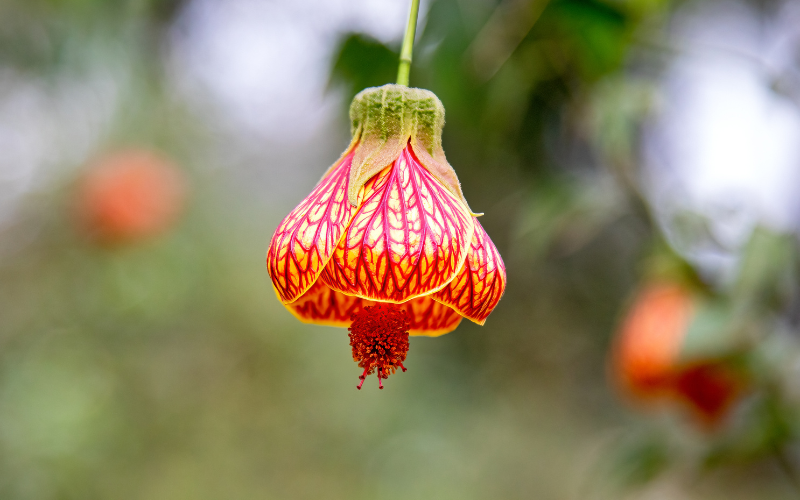
The painted Abutilon is a stunning and vibrant flower. It is also known as Flowering Maple or Chinese Lantern. They come in a range of colors, including shades of orange, red, pink, yellow, and white.
Painted Abutilon plants typically produce flowers throughout the warmer months, often starting in late spring and continuing into the fall. Painted Abutilon plants thrive in partial sun to full sun and prefer well-draining soil.
| Scientific Name | Abutilon pictum |
| Native Range | Southern Brazil, Argentina, Paraguay and Uruguay |
| Flowering Season | Spring to Fall |
Peruvian Lily
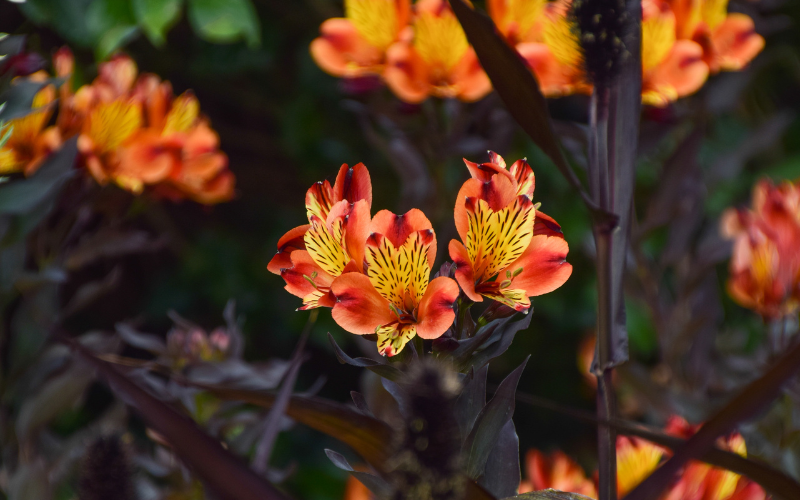
The Peruvian Lily is a beautiful flower. It is scientifically known as Alstroemeria. It is native to South America. Peruvian Lily flowers come in a range of colors, including shades of white, yellow, orange, pink, red, and purple.
Peruvian Lilies typically bloom during the late spring and summer months. Peruvian Lily prefers well-draining soil and a location that receives full to partial sun.
| Scientific Name | Alstroemeria |
| Native Range | South America, although some have become naturalized in the United States, Mexico, Australia, New Zealand, Madeira and the Canary Islands |
| Flowering Season | Early summer to fall |
Pansy
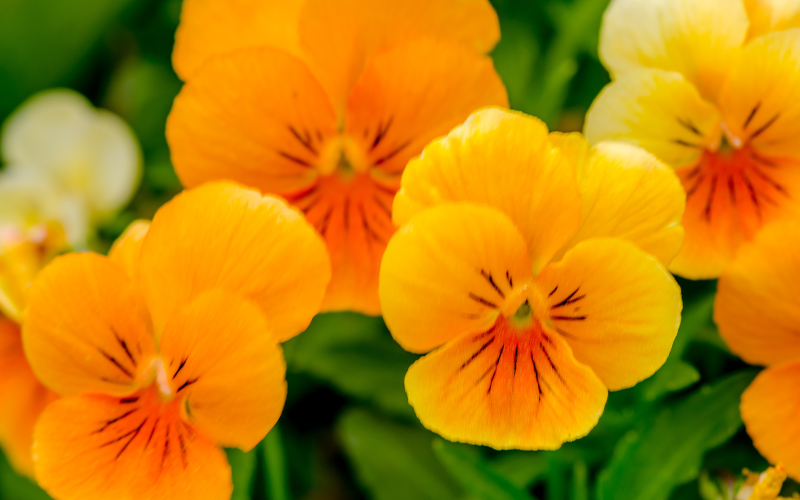
The pansy is a beautiful flower. It is scientifically known as Viola × wittrockiana. Pansies come in a wide range of colors, including shades of purple, yellow, orange, blue, red, and white
. They bloom in the spring and fall. Pansies prefer well-draining soil and moderate sunlight. They thrive in cooler climates and can handle light frosts.
| Scientific Name | Viola tricolor var. hortensis |
| Native Range | Europe, Western Asia and North Africa |
| Flowering Season | Spring to Summer |
Crocosmia
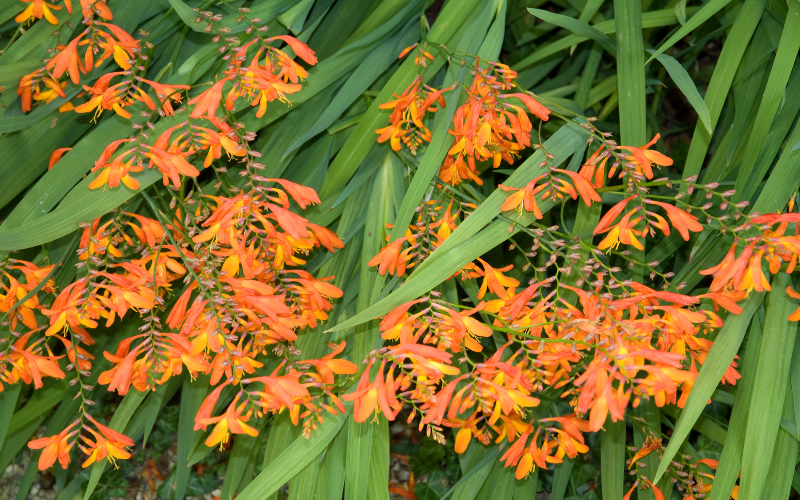
Crocosmia is a stunning and vibrant flower. It is native to Africa and belongs to the iris family. The Crocosmia flowers come in a range of colors, including shades of orange, red, and yellow.
Crocosmia plants thrive in full sun or partial shade. These plants prefer well-draining soil and are relatively low-maintenance. They bloom from mid-summer to early fall.
| Scientific Name | Crocosmia |
| Native Range | Southern Africa |
| Flowering Season | Summer |
Poppy
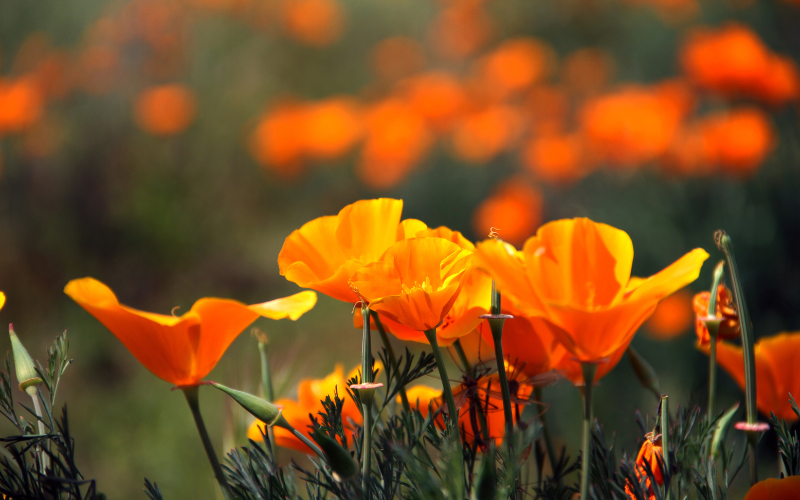
The poppy is a beautiful flower. It is native to various regions, including Europe, Asia, and North America. Poppy flowers typically have large, cup-shaped blooms with four to six petals that radiate from a dark or contrasting-coloured central center.
The flower can come in various colors, including red, orange, pink, white, and even shades of blue and purple. Poppies generally prefer well-drained soil and full sun.
| Scientific Name | Papaver |
| Native Range | East of the Mediterranean Sea |
| Flowering Season | Late Winter to Early Summer |
Canna Lily
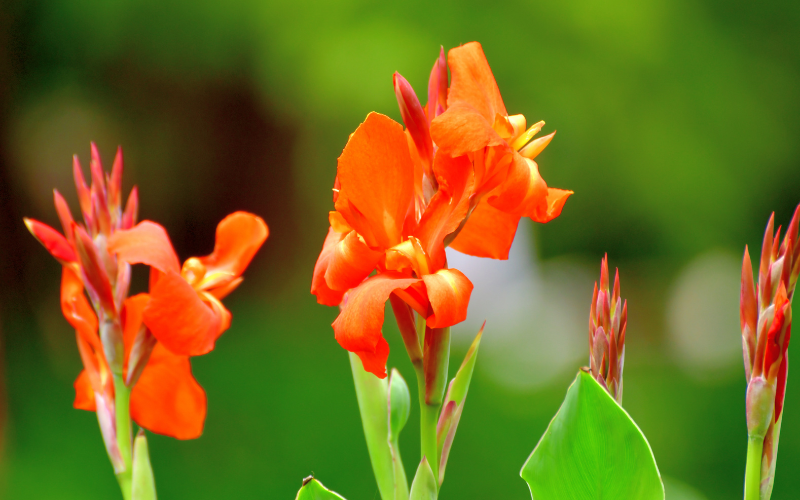
The Canna Lily is a stunning flower. It is native to America. Canna lily flowers come in a wide range of colors, including shades of red, orange, yellow, pink, and even combinations of these colors. Canna lilies thrive in full sun to partial shade.
They prefer well-draining soil that’s kept consistently moist but not waterlogged. In colder climates, canna lilies may need to be dug up and stored indoors during the winter months to protect them from frost.
| Scientific Name | Canna indica |
| Native Range | America |
| Flowering Season | Summer |
Zinnia
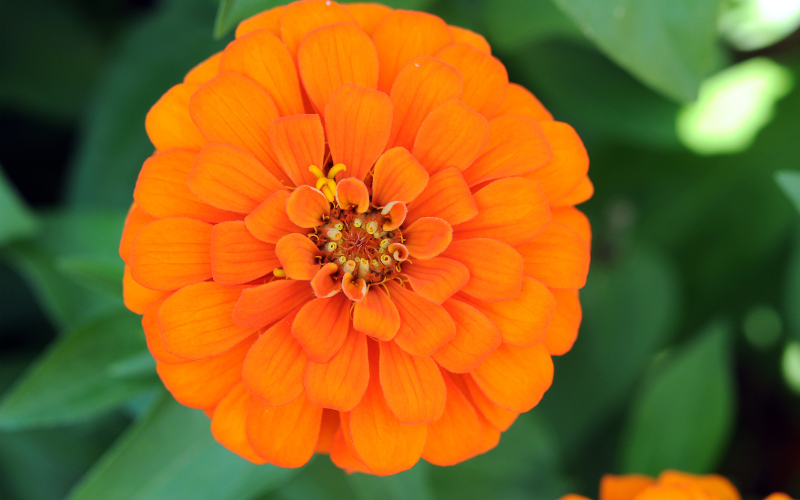
Zinnia is a beautiful flower. It is native to North and South America. Zinnias come in a range of colors, including red, orange, yellow, pink, purple, and white. Zinnias are known for their long blooming period, often lasting from late spring until the first frost in the fall.
Zinnias are relatively easy to grow. Zinnias thrive in full sun and require at least 6 to 8 hours of direct sunlight per day for optimal growth and blooming.
| Scientific Name | Zinnia |
| Native Range | Southwestern United States, Mexico, and Central America |
| Flowering Season | Late Spring until the First Frost in Fall |
Trumpet Vine

The trumpet vine flower is a stunning flower. It is native to the southeastern United States. The flowers are typically bright orange to red in color, but some cultivars may also have shades of yellow.
Trumpet vines typically bloom during the summer months. Trumpet vines prefer full sun to thrive and produce the most flowers. They can tolerate a range of soil types but prefer well-draining soil.
| Scientific Name | Campsis radicans |
| Native Range | New Jersey to Ontario and Iowa, and south to Florida and Texas |
| Flowering Season | Summer and into fall |
Persian Buttercup
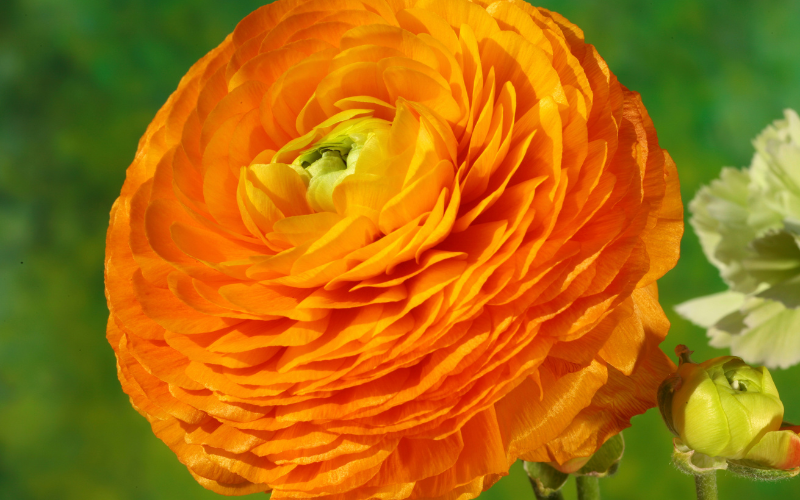
The Persian buttercup is a charming and colorful flowering plant. The flowers come in a wide range of colors, including shades of red, orange, yellow, pink, white, and even bi-colour combinations.
These flowers thrive in cool weather and are often planted in the fall for spring blooms. They prefer well-draining soil and full sun to light shade. Persian buttercups can be grown in containers or pots.
| Scientific Name | Ranunculus asiaticus |
| Native Range | Eastern Mediterranean region, southwestern Asia, southeastern Europe (Crete, Karpathos and Rhodes), and northeastern Africa |
| Flowering Season | Spring, Summer |
Torch Lily
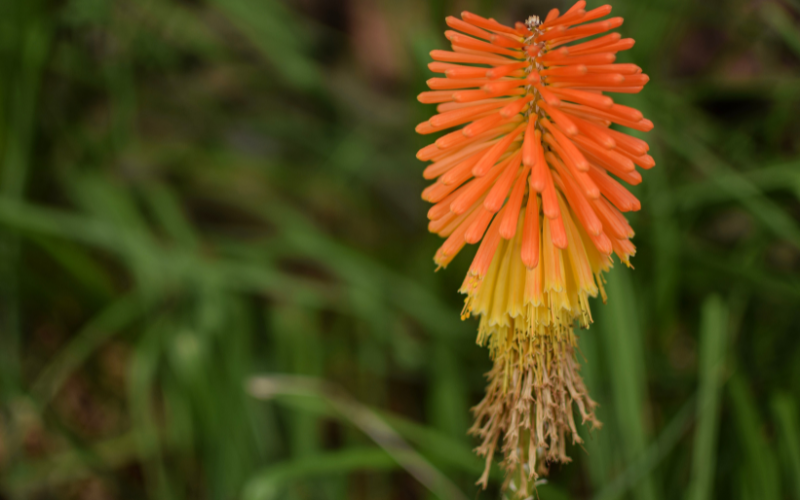
The torch lily is a beautiful flower. It is also known as red hot poker or kniphofia. It is native to Africa. Torch lily flowers come in a range of colors, including shades of red, orange, yellow, and even creamy white.
Torch lilies typically bloom during the summer months. Torch lilies prefer full sun to light shade. They thrive in well-draining soil and are well-suited to dry or rocky areas.
| Scientific Name | Kniphofia |
| Native Range | South Africa |
| Flowering Season | Summer |
Chrysanthemum

The chrysanthemum is a lovely flower. It is native to Asia and northeastern Europe. Chrysanthemums come in a wide range of shapes, sizes, and colors. It is available in a variety of colors, ranging from white, yellow, and pink to red, orange, and even shades of lavender and bronze.
Chrysanthemums can be used in a variety of garden settings, from borders and flower beds to containers and hanging baskets.
| Scientific Name | Chrysanthemum indicum |
| Native Range | East Asia and Northeastern Europe |
| Flowering Season | Late summer or early fall |
Begonia
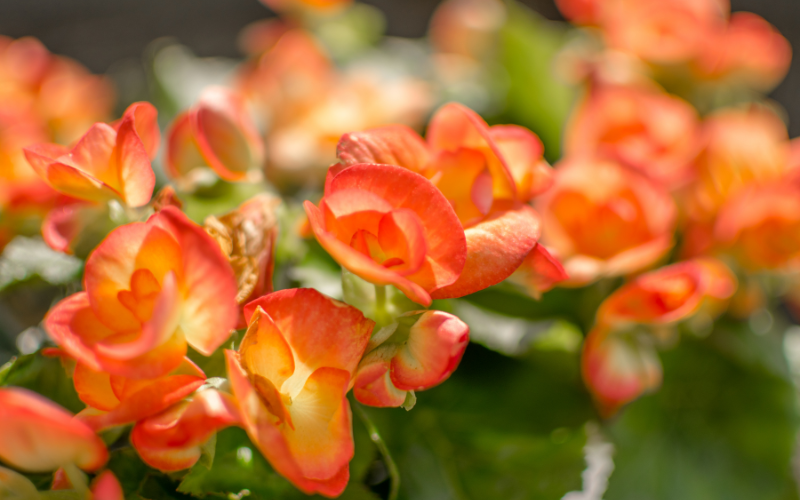
Begonia is a beautiful flower. It is native to tropical and subtropical regions. The flower colors come in a range of white, pink, red, orange, yellow, and even bi-colour combinations.
Begonias can be grown both indoors and outdoors, depending on the species and variety. Begonia prefers well-draining soil, indirect sunlight, and regular moisture.
| Scientific Name | Begonia |
| Native Range | Central and South America, Asia, and sub-Saharan Africa |
| Flowering Season | Summer |
Verawood
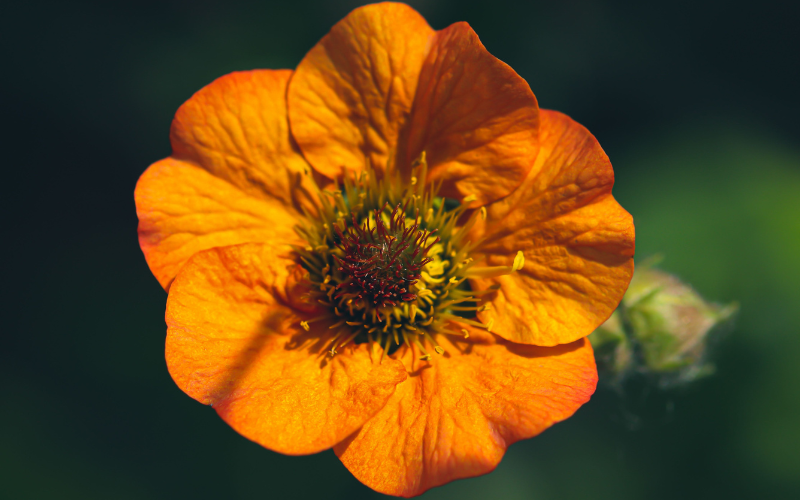
Verawood is a lovely flower. It is also known as Bulnesia sarmientoi. It is native to South America, particularly in Argentina, Paraguay, and Bolivia. These flowers are typically pale yellow to greenish-yellow in color.
The Verawood flower has been used in traditional medicine for its various healing properties.
| Scientific Name | Bulnesia |
| Native Range | South America |
| Flowering Season | Late spring to early summer |
Strawflower
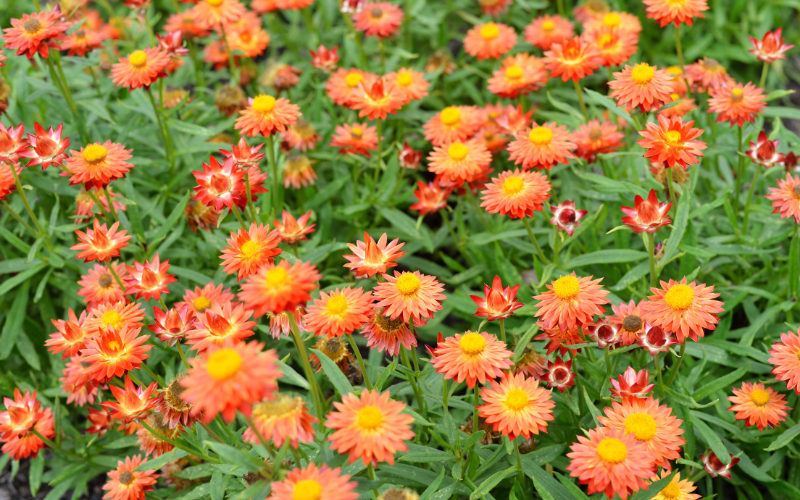
The strawflower is a stunning flower. It is also known as the everlasting flower or paper daisy. It is native to Australia. They produce abundant, daisy-like flowers that come in a variety of vibrant colors, including shades of yellow, orange, pink, red, and white.
Strawflowers bloom in the late spring or summer and continue to produce flowers throughout the growing season. These flowers thrive in full sun and well-draining soil.
| Scientific Name | Xerochrysum bracteatum |
| Native Range | Australia |
| Flowering Season | Spring, Summer, Fall |
Stalked Bulbine
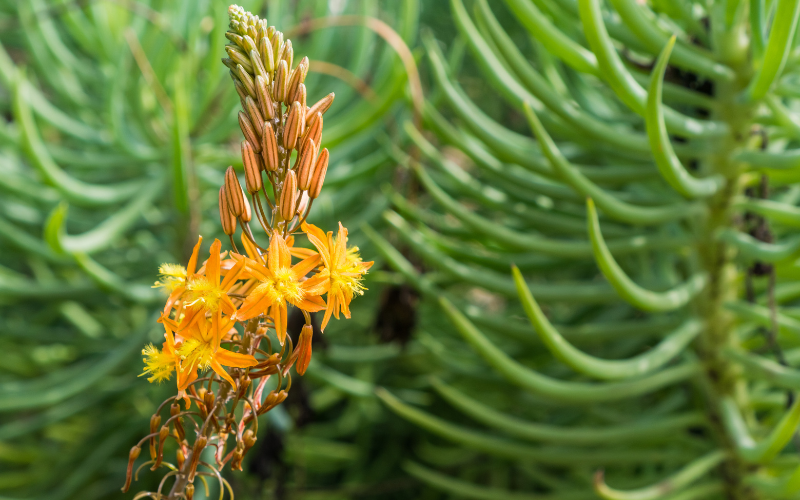
The Stalked Bulbine is a fascinating and stunning flower. It is scientifically known as Bulbine ibolium. It is native to South Africa. The flowers are typically bright yellow or orange.
The flowers appear from late spring through summer and sometimes into early fall. Stalked Bulbine is well-suited to dry and arid climates and thrives in full sun. It is drought-tolerant and prefers well-draining soil.
| Scientific Name | Bulbine frutescens |
| Native Range | South Africa |
| Flowering Season | Spring to Summer |
Spanish Gold
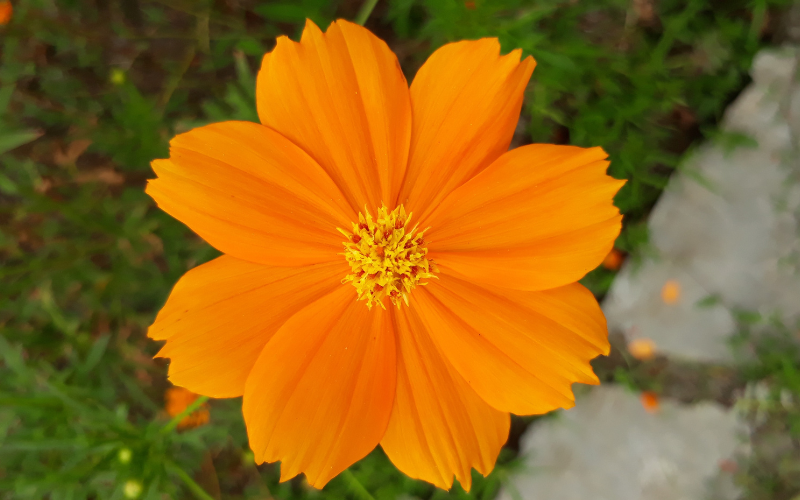
The Spanish gold is a beautiful flower. It is also known as Grindelia papposa. It is natively North American. It typically blooms in late summer and early fall. The Spanish Gold typically grows up to 1 to 3 feet in height.
It prefers well-drained soils. The beauty, cultural significance, and healing capabilities that have made the Spanish Gold Flower a renowned and valued flower around the world are completely represented in this blossom.
| Scientific Name | Grindelia papposa |
| Native Range | North America |
| Flowering Season | Spring |
Rose
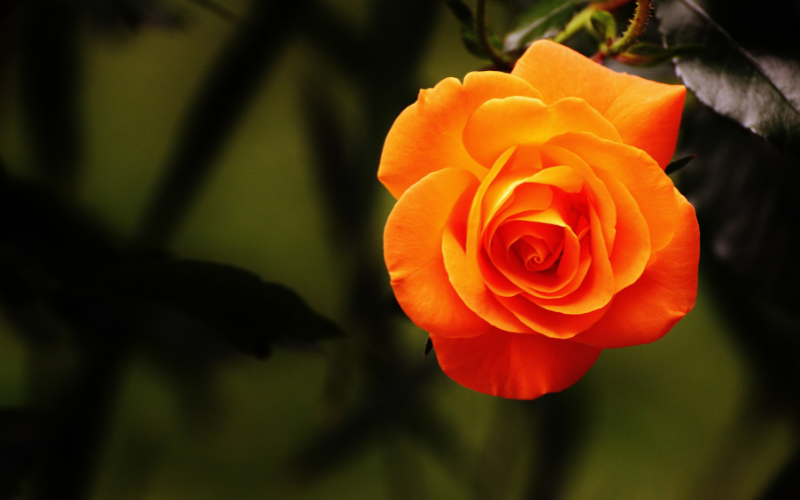
The rose (Rosa) is one of the most beloved and widely cultivated flowers in the world. The flowers come in a wide range of colors, including red, pink, white, yellow, orange, and even multi-colored varieties.
The size of rose bushes and their blooms can vary widely depending on the variety. Roses are rich in symbolism and are often associated with love, passion, beauty, and romance. Roses require well-drained soil, plenty of sunlight, and regular pruning to thrive.
| Scientific Name | Rosa |
| Native Range | Asia, North America, Europe, and Northwest Africa |
| Flowering Season | Late spring and early fall |
Snapdragon
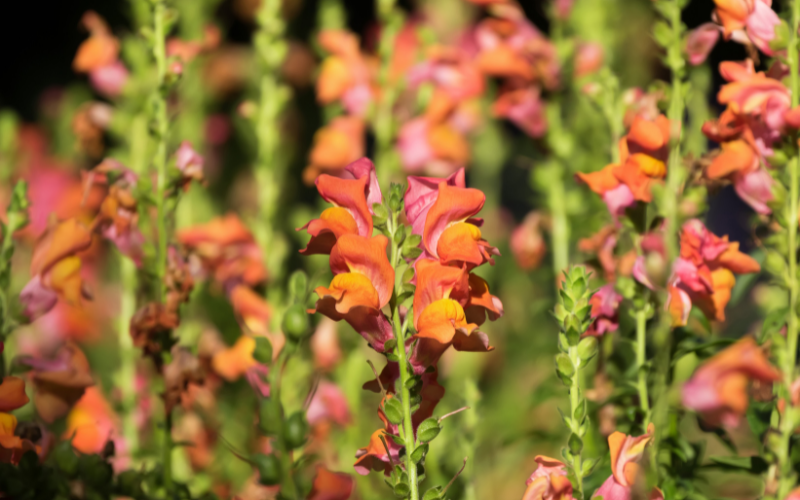
Snapdragon is a gorgeous flower. It is scientifically known as Antirrhinum majus. The Snapdragon flower gets its name from its unique shape, which resembles a dragon’s mouth.
The flowers come in a wide range of colors, including pink, red, orange, yellow, white, and various shades of purple and lavender. The size of each flower can range from small to quite large, depending on the variety.
| Scientific Name | Antirrhinum |
| Native Range | North America |
| Flowering Season | Spring to Fall |
Red Hot Pokers
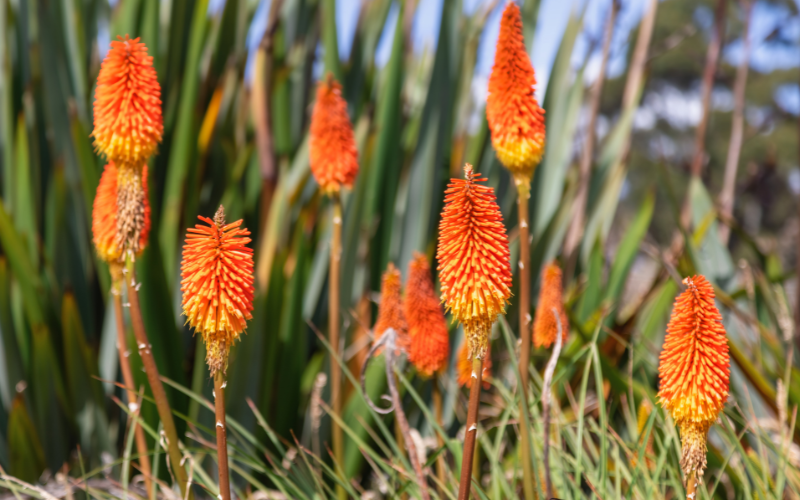
The Red Hot Poker is a stunning flower. It is scientifically known as Kniphofia. It is native to South Africa. The Red Hot Pokers come in a range of fiery and bold colors, including shades of red, orange, and yellow.
The flowers typically bloom from late spring through summer. The Red Hot Pokers thrive in full sun to partial shade. They perform best in well-draining soil.
| Scientific Name | Kniphofia |
| Native Range | South Africa |
| Flowering Season | Late Spring Until Fall |
Sneezeweed
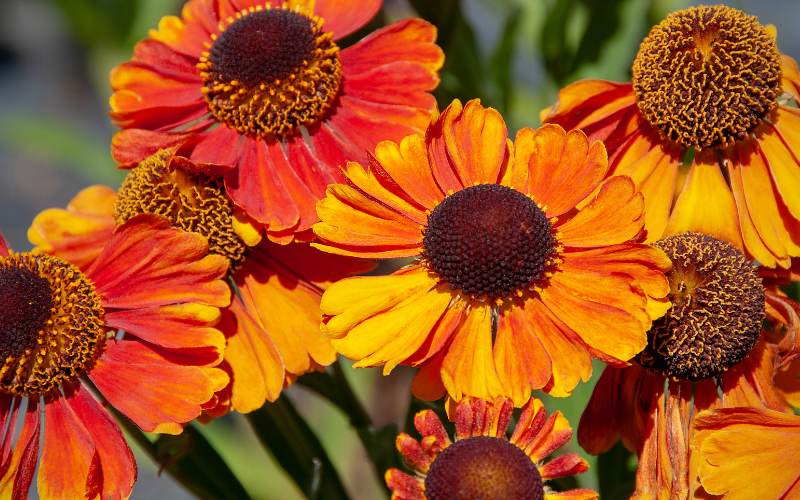
The sneezeweed flower is a stunning and unique flower. It is scientifically known as Helenium. The Sneezeweed flowers come in a range of warm and inviting colors, including shades of yellow, orange, red, and rust.
It is typically blooms from late summer through early fall. It thrives in full sun to partial shade, with full sun exposure often resulting in more prolific flowering.
| Scientific Name | Helenium |
| Native Range | United States |
| Flowering Season | Late Summer to Fall |
Orange Bells
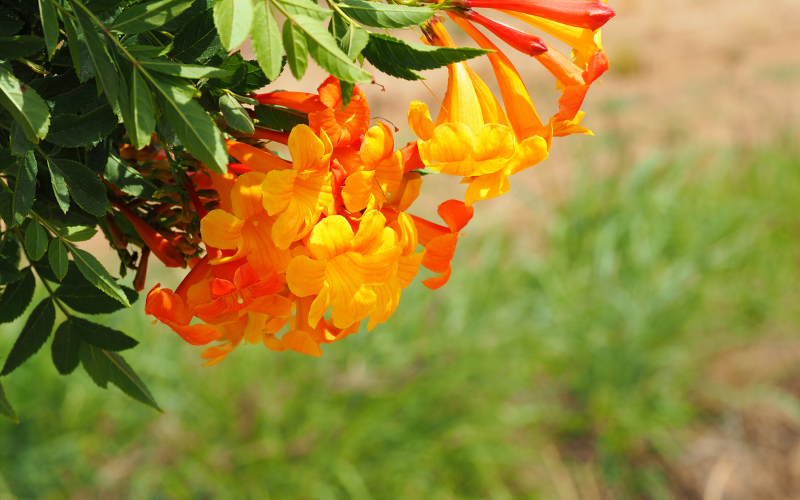
Orange Bells are a lovely flower. It is commonly known as the “Orange Bells of Ireland” or “Moluccella laevis.” Orange bell flowers are small and tubular, with a bell-shaped appearance.
The flowers bloom during the summer months. It thrives in full sun to partial shade. They require a good amount of sunlight to grow and bloom successfully. The flowers are relatively easy to grow and are a great choice for gardeners.
| Scientific Name | Tecoma alata |
| Native Range | United States |
| Flowering Season | Summer to fall |
Montbretia
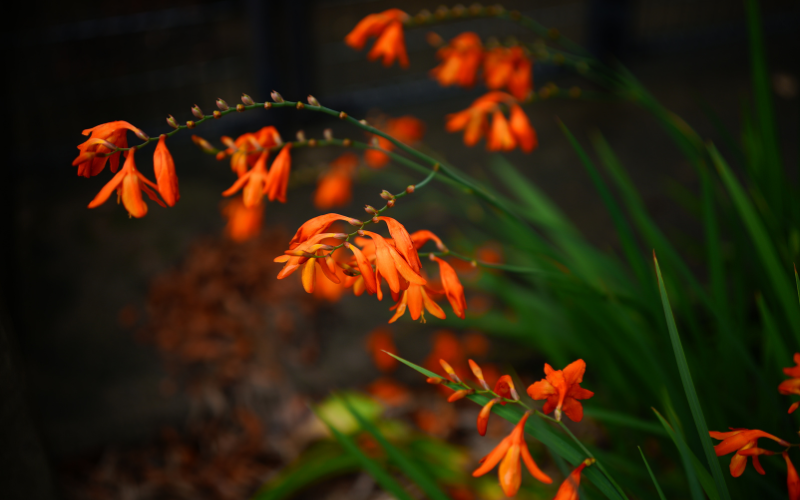
Montbretia is a vibrant and charming flower. It is scientifically known as Crocosmia. It is native to South Africa. They produce tall, arching stems that can reach heights of 2 to 4 feet (about 60 to 120 centimeters).
The flowers come in a range of vibrant and warm colors, including shades of orange, red, yellow, and sometimes even pink. Montbretia is known for its summer and early fall bloom.
| Scientific Name | Crocosmia |
| Native Range | South Africa |
| Flowering Season | Summer |
